The DNA damage response activates HPV16 late gene expression at the level of RNA processing
- PMID: 29596642
- PMCID: PMC6007495
- DOI: 10.1093/nar/gky227
The DNA damage response activates HPV16 late gene expression at the level of RNA processing
Abstract
We show that the alkylating cancer drug melphalan activated the DNA damage response and induced human papillomavirus type 16 (HPV16) late gene expression in an ATM- and Chk1/2-dependent manner. Activation of HPV16 late gene expression included inhibition of the HPV16 early polyadenylation signal that resulted in read-through into the late region of HPV16. This was followed by activation of the exclusively late, HPV16 splice sites SD3632 and SA5639 and production of spliced late L1 mRNAs. Altered HPV16 mRNA processing was paralleled by increased association of phosphorylated BRCA1, BARD1, BCLAF1 and TRAP150 with HPV16 DNA, and increased association of RNA processing factors U2AF65 and hnRNP C with HPV16 mRNAs. These RNA processing factors inhibited HPV16 early polyadenylation and enhanced HPV16 late mRNA splicing, thereby activating HPV16 late gene expression.
Figures

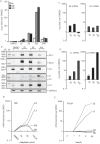
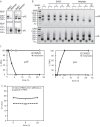

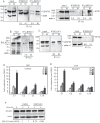

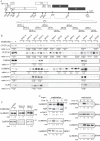
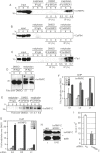
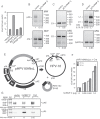
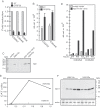
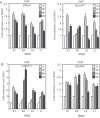
Similar articles
-
Role of the DNA Damage Response in Human Papillomavirus RNA Splicing and Polyadenylation.Int J Mol Sci. 2018 Jun 12;19(6):1735. doi: 10.3390/ijms19061735. Int J Mol Sci. 2018. PMID: 29895741 Free PMC article. Review.
-
hnRNP L controls HPV16 RNA polyadenylation and splicing in an Akt kinase-dependent manner.Nucleic Acids Res. 2017 Sep 19;45(16):9654-9678. doi: 10.1093/nar/gkx606. Nucleic Acids Res. 2017. PMID: 28934469 Free PMC article.
-
Heterogeneous Nuclear Ribonucleoprotein C Proteins Interact with the Human Papillomavirus Type 16 (HPV16) Early 3'-Untranslated Region and Alleviate Suppression of HPV16 Late L1 mRNA Splicing.J Biol Chem. 2015 May 22;290(21):13354-71. doi: 10.1074/jbc.M115.638098. Epub 2015 Apr 15. J Biol Chem. 2015. PMID: 25878250 Free PMC article.
-
Adenosine causes read-through into the late region of the HPV16 genome in a guanosine-dependent manner.Virology. 2018 Aug;521:1-19. doi: 10.1016/j.virol.2018.05.019. Epub 2018 Jun 1. Virology. 2018. PMID: 29864673
-
Splicing and Polyadenylation of Human Papillomavirus Type 16 mRNAs.Int J Mol Sci. 2017 Feb 9;18(2):366. doi: 10.3390/ijms18020366. Int J Mol Sci. 2017. PMID: 28208770 Free PMC article. Review.
Cited by
-
The Role of RNA Splicing Factors in Cancer: Regulation of Viral and Human Gene Expression in Human Papillomavirus-Related Cervical Cancer.Front Cell Dev Biol. 2020 Jun 12;8:474. doi: 10.3389/fcell.2020.00474. eCollection 2020. Front Cell Dev Biol. 2020. PMID: 32596243 Free PMC article. Review.
-
HPV and RNA Binding Proteins: What We Know and What Remains to Be Discovered.Viruses. 2024 May 15;16(5):783. doi: 10.3390/v16050783. Viruses. 2024. PMID: 38793664 Free PMC article. Review.
-
Role of the DNA Damage Response in Human Papillomavirus RNA Splicing and Polyadenylation.Int J Mol Sci. 2018 Jun 12;19(6):1735. doi: 10.3390/ijms19061735. Int J Mol Sci. 2018. PMID: 29895741 Free PMC article. Review.
-
Correlation of HPV16 Gene Status and Gene Expression With Antibody Seropositivity and TIL Status in OPSCC.Front Oncol. 2021 Jan 26;10:591063. doi: 10.3389/fonc.2020.591063. eCollection 2020. Front Oncol. 2021. PMID: 33575210 Free PMC article.
-
Heterogeneous Nuclear Ribonucleoprotein A1 (hnRNP A1) and hnRNP A2 Inhibit Splicing to Human Papillomavirus 16 Splice Site SA409 through a UAG-Containing Sequence in the E7 Coding Region.J Virol. 2020 Sep 29;94(20):e01509-20. doi: 10.1128/JVI.01509-20. Print 2020 Sep 29. J Virol. 2020. PMID: 32759322 Free PMC article.
References
-
- Chow L.T., Broker T.R., Steinberg B.M.. The natural history of human papillomavirus infections of the mucosal epithelia. APMIS. 2010; 118:422–449. - PubMed
-
- Schiffman M., Doorbar J., Wentzensen N., de Sanjose S., Fakhry C., Monk B.J., Stanley M.A., Franceschi S.. Carcinogenic human papillomavirus infection. Nat. Rev. Dis. Primers. 2016; 2:16086. - PubMed
-
- Bouvard V., Baan R., Straif K., Grosse Y., Secretan B., El Ghissassi F., Benbrahim-Tallaa L., Guha N., Freeman C., Galichet L. et al. . A review of human carcinogens–Part B: biological agents. Lancet Oncol. 2009; 10:321–322. - PubMed
-
- Walboomers J.M., Jacobs M.V., Manos M.M., Bosch F.X., Kummer J.A., Shah K.V., Snijders P.J., Peto J., Meijer C.J., Munoz N.. Human papillomavirus is a necessary cause of invasive cervical cancer worldwide. J. Pathol. 1999; 189:12–19. - PubMed
Publication types
MeSH terms
Substances
LinkOut - more resources
Full Text Sources
Other Literature Sources
Research Materials
Miscellaneous

